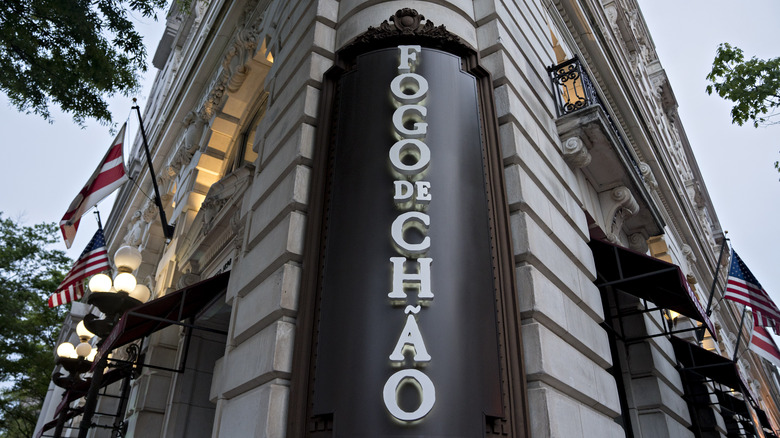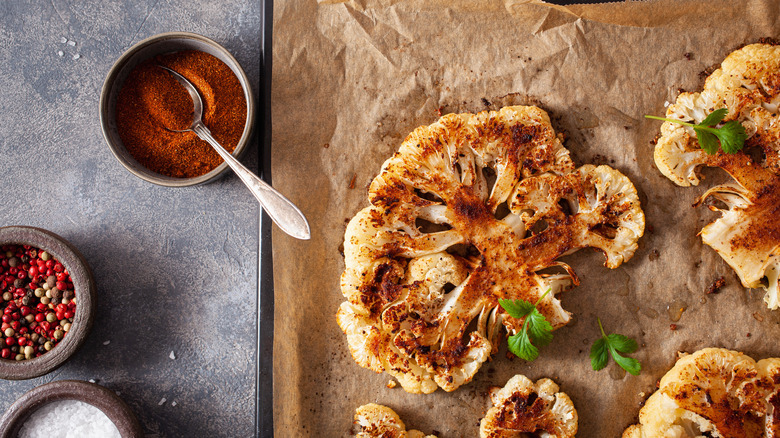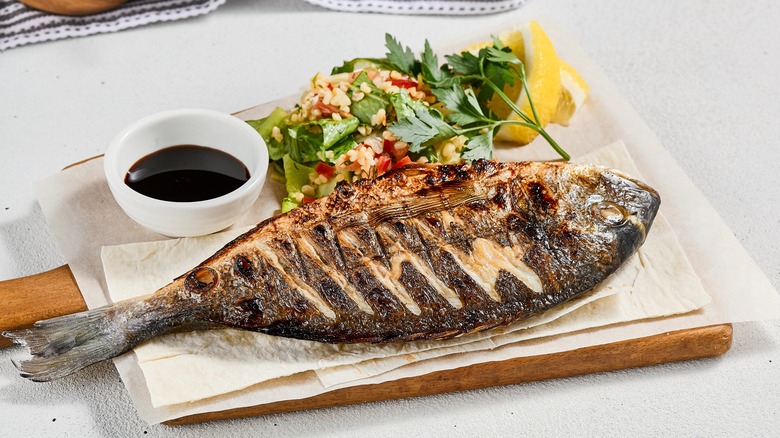8 Big Changes Coming To Fogo De Chao In 2023
Here's a pop quiz for you. How do you turn the diet of a nomad South American cowboy -– the gaucho –- into a popular restaurant concept? With flexibility, that's how. Fogo de Chão, with its ever-changing freshly grilled meat offerings and colorful seasonal fare on its Market Table buffet, epitomizes flexibility. While a dining experience at the Brazilian restaurant chain doesn't include gauchos using bread as plates for their personal cuts of meat the way that traditional South American cowboys would, the spirit of the gaucho's facón knife skills are on display at each table. The chain's servers, called gauchos, slice a variety of fresh meat off the bone for each guest, mimicking the personal food rituals of traditional gauchos, including shared noshing on various cuts of meat.
The challenge now for the restaurant chain's domesticated gauchos is how to adapt their knife skills to a demographic that increasingly would rather eat a cauliflower steak than a T-Bone steak. Again, flexibility is key. The year 2023 marks some big changes for Fogo de Chão's menu, including more vegetarian and vegan offerings, as well as a turn toward non-alcoholic drinks. There's also an important change to the chain's name, which will no longer give a nod to the chain's beefy origins as it moves to adapt to the taste proclivities of younger diners. If you're a fan of Fogo de Chão, here are eight changes that you can expect in 2023 and beyond.
It's rolling out a more expansive menu
Grilled fish. Tantalizing tofu recipes. Tasty vegan and vegetarian dishes like grilled cauliflower steak. This list offers but a taste –- pardon the pun -– of some of the new fare that Fogo de Chão is rolling out this year. If you've suddenly grown worried that you didn't see Brazilian-style barbecued beef, pork, and chicken on the above list, you needn't be. The changes represent an addition to the menu, not a subtraction.
True enough, plans are in the works to delete "steakhouse" from the restaurant's official name. However, expanding its menu is a good strategy in general, one that many restaurants in today's competitive post-pandemic market have been making. A Restaurant Dive report from January 2023 suggests that there has been a 10% decrease in people visiting their favorite local eateries since 2019, but that number is expected to decline as the year progresses. To boost their bottom lines, restaurants should introduce new revenue options, like catering or delivery.
For Fogo de Chão specifically, such a move means giving customers the option to take their favorite cuts of meat home to grill themselves. The Brazilian restaurant chain also offers a wide variety of side dishes and its grilled meat to go. While such options don't give at-home diners the whole knife-wielding gaucho experience, it does offer Fogo de Chão customers a way to celebrate birthdays or anniversaries in the privacy of their own homes and with minimal effort.
It's adding to its vegan and vegetarian options
Here's something to make you go, "Hmmm..." An online Survey of Vegans in 2013 found that more than 78% of the nearly 7,000 respondents were women. It's a mystery that only kind of baffles sociology types who study that sort of thing, but for our purposes, it's fitting to say that the prevailing stereotype is that manly men eat steak and women eat salad. If you want a table at the so-called "men's club," just call up your local steakhouse. And while this has been the prevailing trend for many beef joints, Fogo de Chão bucks this trend. Nearly half of its customers are women.
Fogo de Chão competitors like Ruth's Chris Steakhouse and Outback Steakhouse also offer vegetarian options. For many steakhouses, vegan and vegetarian options consist of foods like broccoli steaks and generous portions of potatoes. Fogo de Chão will take it one step further and introduce plant-based meats from companies like Impossible to remain even more competitive.
It is interesting to note that Ruth's Chris Steakhouse is owned by Darden Restaurants, which owns Olive Garden. The Olive Garden's demographic leans female by nearly 56%, which is similar to Fogo de Chao's. That speaks to the level of competition that casual dining restaurants face and the lengths they'll go to compete for today's restaurant-goer, not just in the steakhouse market but in the broader market as well.
The changes align with Gen X, Millennial, and Gen Z desires
Until the early part of the 21st century, casual restaurants like Red Lobster were happy to cater to Boomers. They were in the heydey of their spending power, and boy, did they love going out to dinner. While many still do, restaurant owners are keenly aware that this population is aging, and if they're to stay in business, they need to cater to new markets. Fogo de Chão has decided to surf with this tide rather than swim out to a ship that already set sail.
The chain has set its sights on Gen X, Millennials, and Gen Z, who make up about 87% of the Brazilian barbecue chain's customer base, per Nation's Restaurant News. The younger generations consider themselves a fairly healthy lot, Gen Z in particular. Fifty-nine percent of them believe they're in good health, and they believe this has largely to do with their diets. Correspondingly, people who eat at casual restaurants want their meals to be nutritious, but they also want them to be economical. With the expansion of its Market Table offerings and its lunch price costing around $15, Fogo de Chão is ready to feed the next generations.
Menu changes could reflect a volatile beef market
By most accounts, the food market is a volatile one, especially the meat market, which according to a White House report, represents nearly half of the price increases that American consumers saw at grocery stores between December 2020 and September 2021. Yet more people in 2022 were treating themselves to a steak dinner at a restaurant, one CNN report suggests. Even with some steakhouse chains reporting as much as a 16% increase in sales as of mid-2022, drought and other extreme weather events, which are an underlying threat to beef supply chains, promise to turn the market on its head.
Some restaurant owners may be considering bumping up the price of their steak sandwiches and burgers from $25 to nearly $30 in response to the price volatility. Others have thought about introducing cuts of lower-quality meats, like flatiron and top sirloin steaks, as a way to deal with beef sticker shock.
As for Fogo de Chão, it has tried to mitigate some of the volatility by offering menu flexibility. It appears to be working. While the chain saw a price increase of 4% in 2023, its competitors' prices rose by 8% to 10%, according to Nation's Restaurant News. Its brand parameters help, too. Instead of wearing the fine-dining mantle that most steakhouses do, it's decidedly casual, which helps it adjust to market shifts, too.
Its flexible menu helps when cutting costs
In recent years, a new trend has sprung up: ugly produce. On the consumer side, people who use companies like Imperfect Foods save up to 60% on their grocery budgets just by buying fruits and vegetables that are too small or too imperfect to sell in grocery stores (via The Dollar Stretcher). If consumers save that much, it's likely that chains like Fogo de Chão, which also buys less-than-perfect produce, also save money. Once these foods get cut up and tossed in one of the restaurant's Market Table salads, it doesn't matter what the fruit or vegetable originally looked like. While Fogo de Chão touts this as a sustainability move -– and in all fairness, it probably is -– it's a smart move financially, too.
Aside from this, Fogo de Chão's ultra-flexible menu gives it a lot of wiggle room when sourcing becomes an issue. CEO Barry McGowan said as much in an interview with Nation's Restaurant News. For fans of the chain, the sometimes daily changes in meat varieties are just part of the Brazilian barbecue experience. On the other hand, if you went to the Olive Garden one day and were told you couldn't order fettuccine Alfredo because the restaurant couldn't source its ingredients, you'd probably be taken aback a bit. That's the brilliance of many of Fogo de Chão's menu changes. Restaurant-goers get the same great experience, and the chain saves money in the process.
Whole fish is on the menu
The 2020 pandemic had far-reaching effects in food production and supply chains, with many of the ripple effects still being felt today. An October 2021 CNBC report stated that beef prices jumped more than 20%, while fish prices saw only an 11% increase. At the time, chicken had seen only an 8.8% increase. That didn't last. Just two years later, chicken prices jumped nearly 16.4%, leaving consumers and restauranteurs wondering how to deal with the fallout.
Beef lovers can blame all of this on too many cows versus not enough trucks and workers to get the stock out to the public. Bird flu damaged the chicken and egg markets. Add drought to the mix, and business as usual becomes way more difficult for steakhouse restaurants ... unless they're Fogo de Chão, in which case, the simple goodness of churrasco and sustainably sourced fish comes to the rescue. Of the major animal proteins, seafood saw the smallest price increase.
Fogo de Chao will introduce churrasco-style fish to its menu in 2023. Fortunately, it doesn't require beef or even a lot of spices. Salt and olive oil, plus the slow-roasting process, give the fish all the flavor it requires. Aside from the chain adding a new taste profile to its menu, its regional sourcing is bound to please Millennials and Gen Zers, who are driving the market push toward more sustainable seafood offerings.
It's tapping into the trend toward low-alcohol consumption
Ask any restaurateur about effective ways to increase sales, and many of them will likely suggest adding a Happy Hour or promoting a wine or cocktail special with dinner. Therein lies one of the many troubles that modern restaurateurs will face when it comes to reaching Millennials and Gen Zers. Per capita, Gen Zers consume 20% less alcohol than their Millennial counterparts, who in turn also imbibe far less than the previous generations did, per World Finance. These generations got the 411 that alcohol ain't so good for you, which kind of puts the kibosh on expectations that the next Happy Hour, with special drinks complete with colorful little umbrellas, would bring restaurants the extra funds they hoped for.
Fogo de Chão isn't fighting this trend. Instead, it is adding drinks to the menu that either have no alcohol whatsoever or are only about 0.05% alcohol, courtesy of the CleanCo brand. For the makers of little cocktail umbrellas, this might be good news. They can still sell their tiny creations to bars and restaurants everywhere. They just won't always be topping an alcohol-filled drink. This isn't to say that Fogo de Chão will do away with its adult beverages. They make appearances on the chain's Happy Hour menu. It's just that now, the chain has a more balanced approach to alcohol sales to better cater to its non-drinking Millennial and Gen Z base.
It's building near Disney and other family-centric places
The family dinner table speaks to the human need to build community: to talk, to laugh, to eat. In fact, it's known that several activities release the so-called bonding hormone, oxytocin, and eating and being around friends and family count as two of them. Intuitively, restaurateurs know this, which is why they build in family-centric areas like malls and the family-centric destination to beat all family-centric destinations, Disney World.
With 16% of its customer base being families, Fogo de Chão has wisely jumped on the kiddie bandwagon. On the most fundamental level, it has removed a big obstacle for parents –- cost. For dinner, parents with kids under age 6 pay zero. Zip. Nada. They pay slightly more for their 7- to 12-year-olds, who eat for half price. Now imagine how well this little factoid will go over with the parents who will eat in the soon-to-be Fogo de Chão near Disney World. Food comes quickly at this mostly buffet-style restaurant, just the remedy hungry families need when they are trying to get over the sensory overload of a day at Disney World.
But the chain is expanding beyond Disney, heading into shopping malls, in places like Bridgewater, New Jersey. In 2022, the chain announced plans to grow over the next two decades to at least 300 restaurants in the U.S. (up from 58 locations in early 2023), according to Restaurant Dive. That's a lot of oxytocin-producing meals.








